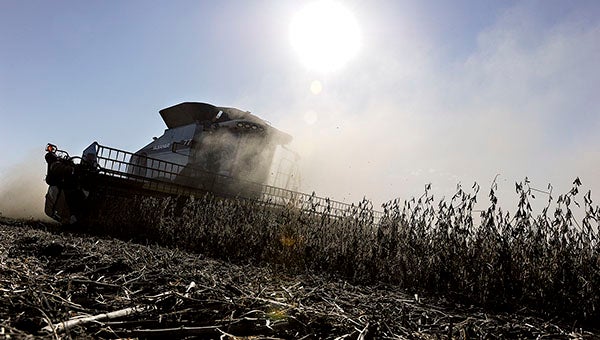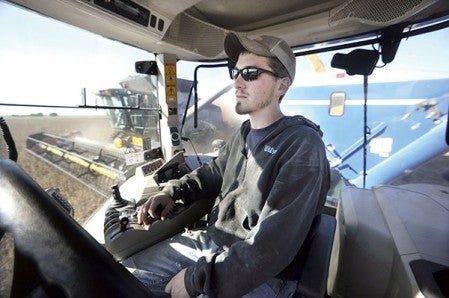A tale of two extremes: Harvest under way in Mower on tough growing year
Published 1:50 pm Sunday, October 13, 2013

Roger Toquam rumbles through a field of soybeans on his farm northeast of Blooming Prairie Thursday afternoon. Eric Johnson/photodesk@austindailyherald.com
Incessant rains finally gave way for extremely late planting this spring in southeastern Minnesota. Then, for the most part, they never returned. Regardless, harvest time has arrived. Despite last week’s downpour, conditions are dry. And combines have been out in force during the past few days, putting the finishing touches on yet another year.
This season has been the tale of two extremes.
Roger Toquam’s big Gleaner combine took its first bite into the beans north of Blooming Prairie on Wednesday. He and his son Isaiah were in the field again Thursday, kicking up big dust clouds in the warm autumn air.
“We started soybeans this year on the day that I finished last year,” Roger said about the harvest.
Given the shortened growing season, the beans were a little sparse. That was to be expected, but Roger had hoped for a little bit better yield.
“It’s definitely below our 10-year average, for sure,” Roger said.
His son, Isaiah, waited nearby with the grain cart.
“This spring was such a — ugh,” he sighed with frustration, “such a mess.”
By the truckload
Had the weather cooperated this spring, along with some timely rains this summer, the outcome would be better. It’s the same story in other areas.

Isaiah Toquam guides his tractor next to his dad, Roger, who was harvesting a field of soybeans northeast of Blooming Prairie Thursday afternoon and dumping a load of beans on the go.
“It’s a tale of two extremes this year,” said Jon Hillier, agronomist with Northern Country Co-Op in Rose Creek. “The yields are down because of the wet spring and wet, late planting conditions — and also the dry August is definitely drawing bean yields down from what everybody would have liked.”
Trucks were fairly busy offloading in Rose Creek on Thursday and Friday, which could be about the busiest days of the year at Northern Country.
“It’s probably as busy as it will get this year,” Hillier said.
Hillier echoed the same thing as others.
“Below average, that’s for sure,” he said about the yields.
Over in Grand Meadow, it’s more of the same talk: below-average bean yields in a late harvest.
“Some guys are having to let some beans sit and wait another week before they’re ready,” said CHS General Manager Deke Stejskal.
Trucks have been offloading beans at CHS the past few days, but not at the fastest pace.
Furthermore, yields are between 30 to 40 bushels per acre, Stejskal said. The results are anywhere from 10 to 20 bushels below a normal season. While much of greater Minnesota is seeing better crops, southeastern Minnesota’s low yields and empty fields could have a lasting local effect. The local grain supply could be stretched, to say the least.
“It’s the year that everybody wants to be over,” Stejskal said. “Start over fresh for next year.”
Furthermore, just a few truckloads of corn have rolled through CHS’ lots, as well. The bulk of the corn harvest, for what is out there, hasn’t begun locally.
Counting on corn
The outlook may be better for area corn crops, those that were actually planted, that is. Farmers got few of their wishes from Mother Nature this year, but she listened when they asked for a late frost. That still has yet to come, which is a very good thing. However, some farmers planted only fractions of their corn this year, and very late. What they did plant came up slow, and thirsty for rain through most of the summer. It’s mid-October, but some of the corn isn’t even fully mature.
“Some of it’s not that far along yet,” Hillier said.
Despite those factors, some are pleased with how the corn has filled out compared to what they expected in June, when many were still planting corn, switching over to beans or throwing in the towel for the insurance checks.
Stejskal thinks yields will widely fluctuate.
“I think you’re going to see corn all over the board,” Stejskal said. “It’s going to depend on planting date, soil type, fertility, tiled ground.”
Back in the combine, Roger approached the south end of the bean field. In his area, the soil is thick, and holds onto moisture better than others. Roger looked out the cab window and recalled the stories about when his grandfather farmed this same land. During the Dust Bowl, the federal government shipped cattle from bone-dry South Dakota to graze on it.
As Roger approached the south end of his bean field, the adjacent cornfield still had a tinge of green to it.
“There is still corn that was planted in June that is not mature yet,” he said.
The corn looks better now than he expected in June.
Roger spoke about dodging disaster by avoiding the early freeze, which could’ve shut down the corn’s growth much too early this year.
“It would have been a disaster for the corn that was planted in June,” he said.
But he also felt bad for those working the fields near Lansing, just a few miles south him. Many of them were picking dry, sparse corn on Thursday.
As soon as they get the chance, though, like others, the Toquams will head full-throttle into the corn. Because of the dry spell, the stalk quality has deteriorated. Hillier agrees with that.
“That’s definitely an issue, too,” Hillier said.
Farmer’s don’t want to run the risk of high winds or heavy storms knocking their crops over. The stalk quality isn’t quite as bad as last year, though.
“The corn stalks last year were literally like a pea shooter,” Roger said. “You could look right through them.”
Along with lower yields, cash corn and bean prices have also fallen, about $3 since spring. Roger, however, stays calm about that sort of thing. There are worse things people are dealing with. And like he said, commodities weren’t going to climb forever. At some point, the market had to shift.
“We knew that day was coming,” he said, as he swung around and headed back north, with visibility reduced to just a few feet by a wall of dust.
Within a few weeks, another season will be in the books, and eyes will be on next year.






